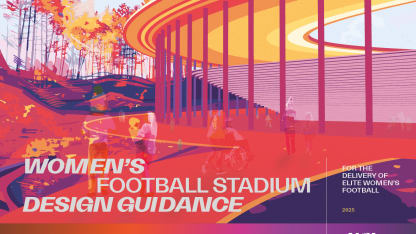WSL Football unveil world-first design guidelines for the delivery of elite women's stadiums

WSL Football have today unveiled Design Guidelines for the Delivery of Elite Women’s Stadiums in England – a world first framework supporting clubs, local authorities, and architects in building or upgrading venues specifically for their women’s teams.
The rapid growth of the women’s game has demonstrated that football venues, which have historically been built and designed for the male player and fan, need to be better equipped to cater towards the specific needs of female athletes and supporters to create a welcoming and inclusive environment, and consequently, become spaces that serve everyone, regardless of their gender.
To explore what women’s stadiums of the future could look like, WSL Football led a comprehensive consultation process alongside AFL Architects, Mott Macdonald and Forward Associates which involved supporters, clubs, current and former players, managers, matchday technical staff including medical professionals and match officials, media, broadcasters, governing bodies, engineers, sports architects and sustainability experts.
Several new approaches were highlighted including a focus on female-friendly changing rooms and toilet facilities, parent/guardian orientated spaces including family toilets and breastfeeding areas, accessibility for those with disabilities and futureproofing for environmental/climate change.
Other key design principles from the guidance document include:
Inclusivity & Accessibility
- An appropriate number of WC provisions, moving from 80%/20% male/female to 45%/45%, with gender neutral facilities to be available (10%).
- The inclusion of baby changing facilities and family toilets for parents with children of the opposite gender.
- Specific rooms for players/staff/media and broadcast talent to breastfeed/care for their child.
- Provision of reflection/multi-faith spaces.
Changing Facilities
- Appropriate changing facilities with a consideration of squad size.
- Separate changing areas for Under-18s.
- An uplifted number of toilets, mirrors, power and lighting.
- Menstruation provisions in changing areas.
- Separate changing facilities for female and male managers/backroom staff.
Fan Experience
- Accessible provisions for disabled supporters, including changing places provisions, audio descriptive commentary and sensory rooms.
- Seat sizes and spacing in stands that are aligned to supporters’ needs.
- Offering supporters the option to sit in a separate area where alcohol is not available if preferred.
- Specified Fanzone area at each stadium.
Facilities & Safety
- Providing safe and well-lit access travel routes to grounds, with clear signage and wayfinding.
- Accessibility, transport connectivity and minimal environmental impact at the heart of site selection.
- Future proofing for environmental/climate change both on and off the pitch.
- Providing water stations and areas of shade.
- Ensuring stadiums are well connected technologically – including internet access – for future developments.
Media/Broadcasters
- Appropriate spaces for broadcasters to conduct interviews pitchside.
- Designated presentation areas/TV studio spaces for broadcasters.
- Specific press conference spaces and mixed zone areas for media.
Hannah Buckley, Head of Safety, Sustainability and Infrastructure for WSL Football – who has led on the development of the guidance – said: “We’re thrilled to unveil this document - it was acknowledged that female specific stadiums were a blind spot in the industry, and the willingness of our stakeholders to come together with their expertise and insights has been inspiring.
“We have a ten-year stadia strategy at WSL Football, and this guidance is one element of that – we want to unlock main stadiums, enhance current assets, and then support our clubs in building new stadiums.
“The rapid growth of the women’s game in recent years has merely highlighted the need for the latter, and to have those spaces designed with the needs of female athletes and fans at the heart of it.
“For ourselves as a league, it is critical that new infrastructure is a part of our clubs’ future plans – to allow the game to continue to grow, stadium primacy – and venues built through the lens of our players - is key, and our hope is that this guidance will be a catalyst for change moving forwards.”
Kathleen Carthy, Architect for AFL Architects, added: “The WSL Stadium Guidance represents a bold and necessary evolution in how we design for the women’s game.
“It’s about creating environments that feel safe, inclusive and vibrant, where fans, players and communities feel a genuine sense of belonging.
“Developed by AFL’s dedicated women’s sports team, the guidance champions a human-centred approach that reflects the values of women’s football, from flexible layouts and equitable facilities to sustainable and welcoming architecture.
“At AFL, we’re proud to have worked alongside the WSL and its stakeholders to help shape a vision that will elevate the matchday experience and set a new standard for the women’s game.”
Technical Director for Buildings, Ruth Shilston, of Mott MacDonald said: "These new women's stadium guidelines have been an opportunity to shape industry standards that will transform the way we design, build and experience football stadiums.
“We’re proud to have brought our decades of experience at the cutting edge of future-proofed building design to embed sustainability and climate resilience as design standards.
“We’re looking forward to seeing them adopted across the industry to help progress sports venues across the UK.”
The guidance document can be viewed in its entirety online at wslfootball.com.